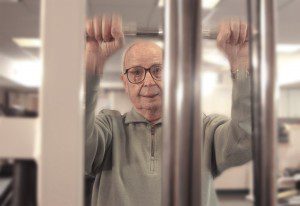20 MINUTES TO FITNESS’ SPECIALIZED WEIGHT TRAINING SHARPLY IMPROVES BONE DENSITY, EVEN IN THE ELDERLY


Consider osteoporosis, a chronic condition caused by the gradual thinning of bone tissue and loss of bone density. Left untreated, it can result in broken bones and increased frailty — the primary reason older adults wind up in nursing homes.
Many osteoporosis treatments are loaded with undesirable side effects, from stomach ulcers and heartburn, to chronic pain, increased cancer risk and deterioration of the jaw bone.
And it’s more common than you might think. Osteoporosis, or its precursor, osteopenia, afflicts one in two women over age 50. Unless they do something to stop it, most can expect to fracture a hip, wrist or vertebra due to loss of bone tissue in their lifetime. Up to 25% of men will experience a similar outcome.
Over the past decade, pharmaceutical companies have responded with a multitude of drugs and hormone therapies designed to increase bone density. And while many may achieve that important goal, they also come loaded with undesirable side effects, from stomach ulcers and heartburn, to chronic pain, increased cancer risk and deterioration of the jaw bone. Side effects like these, in fact, are the primary reason people quit taking their medicine.
Even taking the drugs themselves can be challenging. To help improve absorption rates, bisphosphonates (under brand names like Fosamax), must be taken on an empty stomach to ensure there’s no competition in the gastrointestinal system for the drug. People with intestinal issues often must opt for injections so the medicines can bypass their GI systems altogether.
These and other side effects are one reason why many medical professionals now recommend we focus less on drugs and more on building the strength we need to avoid falls and increase bone mass naturally.
Understanding the cause of osteoporosis — and why 20 Minutes to Fitness strength-training helps reverse it
If you want to blame anyone for the high rate of osteoporosis, you might begin with Mother Nature. She designed the human body to use calcium and phosphate to produce bone. When we’re growing up, we’re very good at it indeed! The body can make new bone faster than it breaks down old bone — at least until our late 20s. That’s when our bone mass typically reaches its peak.
After that, our bones aren’t quite as efficient at making new bone as they are at breaking it down. Calcium and phosphate are sometimes reabsorbed back into our bodies from our bones.
As a result, even healthy adults experience a certain degree of bone loss after age 30.
As we enter our 40s and 50s, it gets worse. In the years directly preceding menopause, women typically lose about 2% of their bone mass a year. Osteoporosis sets in when the body fails to form enough new bone, or when too much old bone is reabsorbed by the body, or both.
It was once thought that the best we can do as we age is to slow bone loss. The good news is, we now know that’s not true. It is possible to rebuild bone density. The even better news: it can be done without drugs. Numerous studies show that strength training can build bone mass, even among older adults. A research study by Ontario’s McMaster University, in fact, found that a year-long strength-training program increased the spinal bone mass of postmenopausal women by nine percent. In earlier research, the University of Florida Medical School found that extremely slow weight-lifting, with appropriate weight, performed on specially designed equipment improves strength, bone density and overall functionality.
Many medical professionals now recommend patients focus less on drugs and more on building the strength to increase bone mass naturally.
Strength-training at 20 Minutes to Fitness: the true “miracle cure”
How does strength training from 20 Minutes to Fitness increase bone mass? Very simply, actually. Think of your skeleton as the living framework upon which your body is built. That’s right — bone is alive, constantly building up and breaking itself down. Load a bone with enough weight, and bone cells called osteoblasts lay down new tissue to make that bone stronger. Lift weights repeatedly in the same way, and you stimulate this activity again and again.
Studies show that high-intensity, slow cadence weight training like that offered at 20 Minutes to Fitness does more than build bone density. It also improves muscle strength and balance which, together with increased bone density, actually increase longevity. These are the very health improvements that can help prevent a bad fall, which is often a turning point in an elderly person’s life. One bad spill can result in a broken hip, which can lead to loss of independence, and worse.
The other good news: it’s never too late to start. Research shows that supervised weight training at 20 Minutes to Fitness can be a safe way to increase bone density in persons in their 80s and 90s. But if you’re younger, don’t wait. The time to start increasing your bone mass is NOW.
 Southwest Florida's Health and Wellness Magazine Health and Wellness Articles
Southwest Florida's Health and Wellness Magazine Health and Wellness Articles

